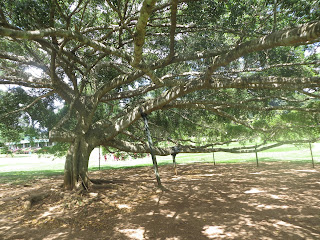RIVER BANK-Prop roots
Adventitious roots, when modified for aerial support, are called prop roots, as in corn or some figs ( Ficus; Moraceae). In many tropical rain forest trees, large woody prop roots develop from adventitious roots on horizontal branches and provide additional anchorage and support.
prop root Any of the modified roots that arise from the stem of certain plants and provide extra support. Such stems are usually tall and slender and the prop roots develop at successively higher levels as the stem elongates, as in the maize plant. Buttress roots, which develop at the base of the trunks of many tropical trees, are similar but tend to have a more flattened appearance. Stilt roots are stouter than prop roots. Those formed at the base of the mangrove tree provide firm anchorage in the soft mud of the swamps.
Adventitious roots, when modified for aerial support, are called prop roots, as in corn or some figs ( Ficus; Moraceae). In many tropical rain forest trees, large woody prop roots develop from adventitious roots on horizontal branches and provide additional anchorage and support
Prop roots in trees like mangrove help it in its surroundings as it is marshy and they help in fixing the tree to the soil . In trees like banyan they just evolved accidentally by evolution and doesn't actually have any survival benefit
Riverbanks with native trees, shrubs and flowers are the most cost effective restoration projects we can implement in the Connecticut River watershed. Restoring riverbank trees and shrubs, which were cut and removed over the years, is an important step toward improved water cleanliness, more stable riverbanks, and better fish & wildlife habitat for our rivers. many organizations have been secured funding to plant native trees and shrubs along the banks of the Connecticut River and its tributaries in order to filter polluted runoff and provide a buffer zone between our streams and land use.
river banks are helping people for cultivating,taking clay in potty industry, and building mud huts houses and many purposes.
People use rivers for transportation and as a source of natural resources. For example, people draw water from rivers to fulfill their drinking, bathing, irrigation, cooking and industrial needs. People also harvest fish, shellfish, mollusks, ducks and other food animals from rivers
Rivers carry water and nutrients to areas all around the earth. They play a very important part in the water cycle, acting as drainage channels for surface water. Rivers drain nearly 75% of the earth's land surface. Rivers provide excellent habitat and food for many of the earth's organisms
prop root Any of the modified roots that arise from the stem of certain plants and provide extra support. Such stems are usually tall and slender and the prop roots develop at successively higher levels as the stem elongates, as in the maize plant. Buttress roots, which develop at the base of the trunks of many tropical trees, are similar but tend to have a more flattened appearance. Stilt roots are stouter than prop roots. Those formed at the base of the mangrove tree provide firm anchorage in the soft mud of the swamps.
Adventitious roots, when modified for aerial support, are called prop roots, as in corn or some figs ( Ficus; Moraceae). In many tropical rain forest trees, large woody prop roots develop from adventitious roots on horizontal branches and provide additional anchorage and support
Prop roots in trees like mangrove help it in its surroundings as it is marshy and they help in fixing the tree to the soil . In trees like banyan they just evolved accidentally by evolution and doesn't actually have any survival benefit
Riverbanks with native trees, shrubs and flowers are the most cost effective restoration projects we can implement in the Connecticut River watershed. Restoring riverbank trees and shrubs, which were cut and removed over the years, is an important step toward improved water cleanliness, more stable riverbanks, and better fish & wildlife habitat for our rivers. many organizations have been secured funding to plant native trees and shrubs along the banks of the Connecticut River and its tributaries in order to filter polluted runoff and provide a buffer zone between our streams and land use.
river banks are helping people for cultivating,taking clay in potty industry, and building mud huts houses and many purposes.
People use rivers for transportation and as a source of natural resources. For example, people draw water from rivers to fulfill their drinking, bathing, irrigation, cooking and industrial needs. People also harvest fish, shellfish, mollusks, ducks and other food animals from rivers
Rivers carry water and nutrients to areas all around the earth. They play a very important part in the water cycle, acting as drainage channels for surface water. Rivers drain nearly 75% of the earth's land surface. Rivers provide excellent habitat and food for many of the earth's organisms




Comments
Post a Comment